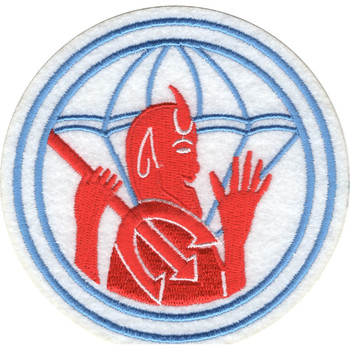Description
504th Airborne Infantry Regiment Patch Strike Hold (U.S. Army) 3.25" x 3.50" Embroidered Patch with Iron-On Backing
Superior Materials: Made with premium polyester thread and durable twill fabric, ensuring long-lasting color and strength.
Advanced Embroidery Technology: Crafted using the most advanced embroidery machinery, guaranteeing intricate detail, sharp lines, and consistent quality every time.
Easy Iron-On Application: Features a heat-activated adhesive backing for quick, no-sew attachment. Simply position, iron, and press for a secure bond.
Versatile Use: Perfect for personalizing jackets, backpacks, uniforms, or any fabric surface that needs a touch of personality.
Durable and Washable: Designed to withstand everyday wear and occasional washing without fading or fraying.
Formations & Origins
The 504th Parachute Infantry Regiment was activated on May 1, 1942, at Fort Benning, Georgia, in response to the U.S. Army's decision to establish a formidable airborne capability. The idea was revolutionary—create a force of elite soldiers who could be dropped by parachute behind enemy lines to seize key objectives, disrupt enemy movements, and hold terrain until conventional forces could link up. The 504th was part of this cutting-edge doctrine, born in the crucible of necessity as the United States prepared for a global war on multiple continents.
Originally attached to the 82nd Infantry Division, which soon transitioned to airborne status, the 504th became one of the first parachute infantry regiments in U.S. military history. It quickly earned a reputation for being tough, disciplined, and fearless. The regimental motto, "Strike Hold," symbolized the unit's mission: once they hit the ground, they were to strike fast and never give up the objective, no matter how fierce the enemy response.
The unit's nickname, "Devils in Baggy Pants," was earned in Italy, reportedly taken from the diary of a dead German officer who described the ferocity and relentlessness of the American paratroopers. Their patch features a winged sword and a blue shield, a perfect visual encapsulation of swift, airborne violence paired with steadfast defense.
Notable Commanders
Colonel Reuben H. Tucker III was the 504th’s most legendary commander and the man who led them through most of World War II. A West Point graduate and natural leader, Tucker was a firm but deeply respected officer who insisted on nothing less than absolute readiness and combat discipline. His presence on the battlefield was well-known, and he was famous for sharing the dangers of frontline combat with his men rather than commanding from a safe distance.
Under Tucker, the 504th became a hardened fighting force, earning battle honors in some of the most challenging campaigns of the war. He didn’t just lead the regiment—he defined it, shaping its culture, its ethos, and its combat reputation.
Major Campaigns/Operations
The 504th’s baptism of fire came during Operation Husky, the invasion of Sicily in July 1943. It was one of the first major airborne operations in U.S. history. Although plagued by misdrops and friendly fire, the 504th quickly proved itself in intense combat against Italian and German forces.
Next came Operation Avalanche—the Allied invasion of mainland Italy. The 504th parachuted into Salerno to bolster ground forces during a desperate battle against German counterattacks. Their arrival turned the tide, and their tenacity under fire helped secure the beachhead.
The fighting at Anzio was among the regiment’s most brutal. Holding the line under constant artillery and infantry assaults for months, the 504th endured hellish conditions. Their ability to absorb punishment without giving ground became legendary.
Although held in reserve for D-Day due to earlier heavy casualties, the 504th returned to the fight during Operation Market Garden. They parachuted into the Netherlands to seize key bridges over the Waal River and fought house to house in Nijmegen. The river crossing under fire to take the Nijmegen Bridge is one of the most heroic actions in airborne history.
They also played a key role in the Battle of the Bulge, rushed into the Ardennes during the German offensive in December 1944. Operating in freezing conditions, often with limited supplies, the 504th helped blunt the last major Axis assault on the Western Front.
Specialized Role/Equipment
The 504th was designed as a light infantry regiment deployed by parachute. This gave it strategic mobility and allowed it to hit deep behind enemy lines. But being light meant sacrificing heavy firepower and armor—paratroopers were expected to fight with what they carried on their backs and secure their objectives until relieved by conventional forces.
In World War II, their standard equipment included M1 Garand rifles, Thompson submachine guns, Browning Automatic Rifles, and grenades. Each paratrooper carried everything from ammunition and demolition charges to rations and medical kits. The risk of becoming isolated or cut off was ever-present.
In modern times, the 504th remains part of the 82nd Airborne Division’s rapid deployment force, capable of deploying anywhere in the world within 18 hours. They now operate with advanced night vision, encrypted communications, GPS systems, and modern assault rifles like the M4A1. Their tactical mobility is supported by vehicles like the M1151 HMMWV and Joint Light Tactical Vehicles, but their fighting spirit remains rooted in their airborne legacy.
Acts of Heroism
Few actions define the bravery of the 504th like the crossing of the Waal River in September 1944. As part of Operation Market Garden, elements of the regiment were ordered to seize the Nijmegen Bridge. The only way to do so was by crossing a wide river in flimsy canvas boats, under direct fire from German machine guns, mortars, and artillery. Paratroopers paddled through blood and bullets, many killed before reaching the far bank. But those who survived stormed the German defenses and secured the bridge, a move that may have saved the operation from total collapse. It was an act of collective valor that still echoes in airborne tradition.
In the Battle of Anzio, 504th paratroopers withstood endless shelling and repeated assaults. Many fought hand-to-hand, often outnumbered and low on supplies. Their ability to hold the line under such conditions earned them one of the first Presidential Unit Citations awarded to an airborne regiment.
In the post-war era, the 504th has seen continuous action. From Panama to Iraq and Afghanistan, paratroopers from the regiment have earned numerous Silver Stars, Bronze Stars, and Purple Hearts. Their courage in clearing enemy compounds, rescuing wounded comrades under fire, and engaging insurgents in dense urban terrain has carried forward the same grit shown in Sicily and Holland.
Legacy & Notable Achievements
The 504th Parachute Infantry Regiment is one of the most decorated airborne units in American history. Its lineage continues today with battalions serving in the 1st and 2nd Brigades of the 82nd Airborne Division. Their motto, "Strike Hold," is not a relic—it’s a mission statement.
Their nickname, "Devils in Baggy Pants," is worn with pride, honoring the men who first earned it in the hills of Italy. The regiment has received multiple Presidential Unit Citations, foreign awards from Allied nations, and the respect of friend and foe alike.
Today, the 504th is part of the Army’s Global Response Force, standing ready to deploy on short notice to crises around the globe. Whether evacuating embassies, securing airfields, or fighting insurgents, they remain true to their legacy.
They are not just soldiers. They are paratroopers—men and women who leap from planes into the unknown, with nothing but their training, their weapons, and each other. The 504th doesn’t wait for the war to come to them. They jump into it.







